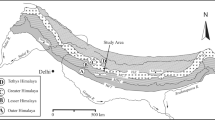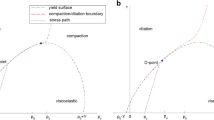Abstract
The Weverton quartzites in the Maryland Blue Ridge are deformed by one major period of greenschist-grade deformation. The components of finite strain due to different independent mechanisms have been measured for these rocks. The total strain is split up into two major components:
The finite natural strain caused by dislocation creep (ɛd) is measured by a new technique using folded and stretched rutile needles which are good strain markers within the quartz crystals. Pressure solution strain (ɛp) is measured from the ratio of the area of new crystals and fibers to the whole rock area in principal sections. Grain boundary sliding is a dependent process which accompanies both mechanisms. Pressure solution obeys a linear Newtonian flow law, \(\left| {\dot \gamma _0^p } \right| = A_p \left| {\tau _0 } \right|\), while dislocation creep obeys a power law of the form \(\left| {\dot \gamma _0^d } \right| = A_d \left| {\tau _0 } \right|^n \) where \(\dot \gamma _0^p ,\dot \gamma _0^d \) are octahedral shear strain rates, τ0 is the octahedral shear stress and A p , A p and n are constants. A direct correlation between finite strain measurements and the operating flow laws can be made. Application of these methods and principles to a few field examples indicates that the rocks obey a flow law partly governed by each mechanism. Any set of physical conditions defines a unique flow law and there is a transition in creep behavior from dominantly Newtonian to a power law with increasing strain rate.
Similar content being viewed by others
Abbreviations
- T :
-
Stretch (= l′/l 0)
- ɛt :
-
Total natural strain (= In T)
- ɛp, ɛd :
-
Natural strain due to pressure solution and dislocation creep
- \(\dot \varepsilon ,\overline {\dot \varepsilon } \) :
-
Natural strain rate and average strain rate
- T:
-
Axial ratio of strain ellipsoid
- a > b >c:
-
Principal semi-axes of strain ellipsoid
- γ0, \(\dot \gamma _0 \) :
-
Natural octahedral shear strain and strain rate
- ν:
-
Lode's number
- θ:
-
Angle between principal axes of p.s. and d.c. strain ellipsoids
- \(\hat \gamma _0 \) :
-
Octahedral strain activity
- σ d :
-
Deviatoric stress.
- τ0 :
-
Octahedral shear component of deviatoric stress
- Γp, Γd :
-
Fractions of total strain contributed by pressure solution and dislocation creep
- Ac/At, Bc/Bt:
-
Area ratios of fibers to whole rock for a — c and b — c principal sections
- D gb , D l :
-
Grain boundary and lattice diffusion coefficients
- X :
-
Grain size
- r :
-
Axial ratio of grain
- Ω:
-
Atomic volume of diffusing species
- h :
-
Width of grain boundary
- k :
-
Boltzman's constant
- T c :
-
Critical temperature for hydrolytic weakening
- T m :
-
Temperature of melting
References
Ashby, M.F.: A first report on deformation-mechanism maps. Acta Met. 20, 887–895 (1972)
Blacic, J.D.: Plastic deformation mechanisms in quartz: the effect of water. Tectonophysics 27, 271–294 (1975)
Boullier, A.M., Gueguen, Y.: SP-Mylonites: Origin of some mylonites by superplastic flow. Contrib. Mineral. Petrol. 50, 93–104 (1975)
Carter, N.L., Christie, J.M., Griggs, D.T.: Experimental deformation and recrystallization of quartz: J. Geol. 72, 687–733 (1964)
Christie, J. M., Ardell, A.J.: Substructures of deformation lamellae in quartz. Geology Vol. 405–408 (1974)
Christie, J.M., Griggs, D.T., Carter, N.L.: Experimental evidence of basal slip in quartz: J. Geol. 72, 734–756 (1964)
Coble, R.L.: A model for boundary diffusion controlled creep in polycrystalline materials: J. Appl. Phys. 34, 1679–1682 (1963)
Crussard, C., Tamhankar, R.: High temperature diffusion of steels: A study of equicohesion, activation energies, and structural modifications: Trans. AIME 212, 718–730 (1958)
Durney, D.W., Ramsay, J.G.: Incremental strains measured by syntectonic crystal growths. In: De Jong, K.A., Scholten, R. (eds.), Gravity and tectonics, p. 502. New York: Wiley 1973
Elliott, D.: Determination of finite strain and initial shape from deformed elliptical objects: Geol. Soc. Am. Bull. 81, 2221–2236 (1970)
Elliott, D.: Deformation paths in structural geology: Geol. Soc. Am. Bull. 83, 2621–2638 (1972)
Elliott, D.: Diffusion flow laws in metamorphic rocks: Geol. Soc. Am. Bull. 84, 2645–2664 (1973)
Frondel, C.: The system of mineralogy of Dana, J. D., and Dana, E. S. V. 3, p. 334. New York: Wiley 1962
Gifkins, R.C.: Transitions in creep behavior. J. Materials 5, 156–165 (1970)
Glen, J.W.: The flow law of ice: Symp. Chamonix, p. 171–183 (1958)
Green, H.W., Radcliffe, S.V.: The nature of deformation lamellae in silicates. Geol. Soc. Am. Bull. 83, 847–852 (1972)
Green, W.V., Gillis, P.P., Zukas, E.G.: Subgrain boundary changes caused by creep deformation. Acta Met. 18, 43–52 (1970)
Griggs, D.T.: Hydrolytic weakening of quartz and other silicates. Royal Astron. Soc. Geophys. J. 14, 19–31 (1967)
Griggs, D.T.: A model of hydrolytic weakening in quartz. J. Geophys. Res. 79, 1653–1661 (1974)
Griggs, D.T., Blacic, J.D.: The strength of quartz in the ductile regime (abstract). EOS Trans. AGU 45, 102–103 (1964)
Groshong, R.H. Jr.: Deformation by pressure solution. Geol. Soc. Am. Abs. with programs 4, 17–18 (1972)
Herring, C.: Diffusional viscosity of a polycrystalline solid. J. Appl. Phys. 21, 437–445 (1950)
Jeffries, Z.: The amorphous metal hypothesis and equicohesive temperatures. J. Am. Inst. Metals 11, 300–324 (1917)
Langdon, T.G.: Grain boundary sliding as a deformation mechanism during creep. Phil. Mag. 20, 689–700 (1970)
Langdon, T.G.: The significance of grain boundaries in high-temperature creep. Can. Met. Quart. 13, 223–228 (1974)
Lifshitz, I.M.: On the theory of diffusion-Viscous flow of polycrystalline bodies. Soviet Physics, JETP 17, 909–920 (1963)
McLaren, A.C., Retchford, J.A.: Transmission electron microscope study of the dislocations in plastically deformed synthetic quartz. Phys. Stat. Sol. 33, 657–668 (1969)
McLean, D.: Creep processes in coarse grained aluminium. J. Inst. Metals 80, 507–519 (1951)
McLean, D.: Crystal fragmentation in aluminium during creep. J. Inst. Metals 81, 287–292 (1952)
McLean, D.: Grain boundary sliding: A finite but unbounded limit. Met. Sci. J. 41, 144–146 (1970)
Mises, R. von: Mechanik der Plastischen Formänderung von Kristallen. Z. Angew. Math. Mech. 8, 161 (1928)
Mitra, S.: Deformation mechanisms and folding in the Weverton quartzites (abstract). EOS, Trans. A.G.U. 56, 445 (1975)
Nabarro, F.R.N.: Deformation of crystals by the motion of single ions. In: Report of a conference on the strength of solids. Phys. Soc. (London) Proc. 75 (1948)
Nadai, A.: Theory of flow and fracture of solids. Vol. I, p. 572. New York: McGraw-Hill 1950
Nye, J.F.: The distribution of stress and velocity in glaciers and ice sheets. Proc. Roy. Soc. (London) Ser. A, 239, No. 1216, 113–133 (1957)
Odqvist, F.K.G.: Theory of creep under combined stresses with application to Machinery. Roy. Swed. Acad. Eng. Res. Proc. 141, 31 (1936)
Odqvist, F.K.G.: Mathematical theory of creep and creep rupture. Oxford University Press, p. 168, 1966
Preston, J.: Quartz lamellae in some Finnish quartzites. Bulletin de la Commision geologique de Finlande No. 180, p. 65–77 (1958)
Rachinger, W.A.: Relative grain translations in the plastic flow of aluminium. J. Inst. Metals 81, 33–41 (1952)
Raj, R., Ashby, M.F.: On grain boundary sliding and diffusional creep. Metallurg. Trans. 2, 1113–1127 (1971)
Stevens, R.N.: Grain-boundary sliding and diffusion creep in polycrystalline solids. Phil. Mag. 23, 265–283 (1971)
Stocker, R.L., Ashby, M.F.: On the rheology of the upper mantle. Rev. Geophys. and Space Physics 11, 391–426 (1973)
Stromgaard, K.E.: Stress distribution during formation of boudinage and pressure shadows. Tectonophysics 16, 215–248 (1973)
Voll, G.: New work on petrofabrics. Geol. J. 2, 503–567 (1960)
Weertman, J.: The creep strength of the earth's mantle. Rev. Geophysics 8, 145–168 (1970)
White, S.: The dislocation structures responsible for the optical effects in some naturally deformed quartzites. J. Material Sci. 8, 490–499 (1973)
Wickham, J.S.: An estimate of strain increments in a naturally deformed carbonate rock. Am. J. Sci. 273, 23–47 (1973)
Wickham, J.S., Elliott, D.: Rotation and strain history in folded carbonates, Front Royal area, Northern Virginia. Trans. A.G.U. 51, 422 (1970)
Author information
Authors and Affiliations
Additional information
This research was supported by NSF Grant. No. DES 74-17467 of the Earth Sciences section to D. Elliott.
Rights and permissions
About this article
Cite this article
Mitra, S. A quantitative study of deformation mechanisms and finite strain in quartzites. Contr. Mineral. and Petrol. 59, 203–226 (1976). https://doi.org/10.1007/BF00371309
Received:
Accepted:
Issue Date:
DOI: https://doi.org/10.1007/BF00371309




